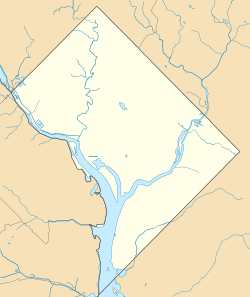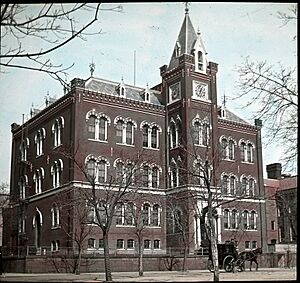Charles Sumner School facts for kids
Quick facts for kids |
|
|
Charles Sumner School
|
|

Charles Sumner School in 2020
|
|
| Location | 1201 17th Street, NW Washington, D.C. |
|---|---|
| Area | 0.3 acres (0.12 ha) |
| Built | 1872 |
| Architect | Adolf Cluss Robert I. Fleming |
| Architectural style | Romanesque Revival |
| NRHP reference No. | 79003150 |
| Added to NRHP | December 20, 1979 |
The Charles Sumner School, built in 1872, was one of the first schools for African American students in Washington, D.C.. It was named after Charles Sumner, an important leader who worked to end slavery.
This school became the first college for training black teachers in the city. It also served as the main office for the separate school system for African American students. Today, the building holds a small museum, a research room, art shows, and old records from the District of Columbia Public Schools.
Building the School and Its Name
The Charles Sumner School was built on land that had been used for a school by the Freedmen's Bureau. This group was created after the Civil War to help people who had been freed from slavery.
The school was named after Charles Sumner. He was a well-known leader from Massachusetts who fought against slavery. He also worked to make sure black citizens could use public transportation like streetcars in Washington, D.C.
The building was designed by a famous architect named Adolf Cluss. He even won an award for his design at a big exhibition in Vienna in 1873. The school officially opened its doors in 1872.
The School's History
In 1862, a law was passed that said schools must be created for black children in Washington, D.C. However, it wasn't until 1873 that local leaders took over running these schools from the federal government.
At that time, different leaders were chosen to manage the schools for white children and black children separately. The Charles Sumner School was one of the first schools in this new system. It had classes for young students and also a high school. This high school later became the famous Dunbar High School. Its first high school students graduated in 1877.
In that same year, the school was renamed the Myrtilla Miner Normal School. It became the first college in the District to train African American teachers. Besides being a school, the building was also the main office for the leaders of the separate school system for black students.
The School as a Museum
By the 1980s, the building was in poor condition. A person named Richard Hurlbut led a group of citizens to raise $5 million to fix it up. The renovation project took two years, from 1984 to 1986.
The newly repaired building was renamed the Charles Sumner School Museum and Archives. It became a museum, and Richard Hurlbut was its first manager. It also houses the old records of the District of Columbia Public Schools. There are reading rooms and meeting spaces too.
The D.C. Women's Hall of Fame is also located at the Charles Sumner School. Local artists and groups use the building to show their work. The building was recognized as a historic site in Washington, D.C., in 1978. It was added to the National Register of Historic Places in 1979.





